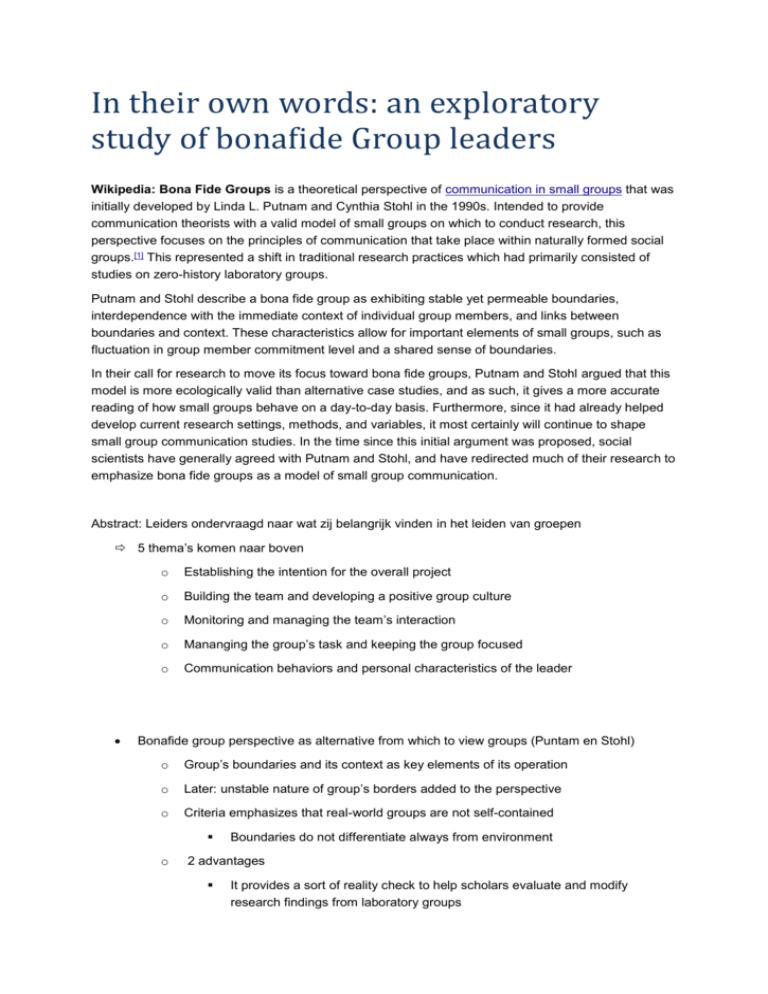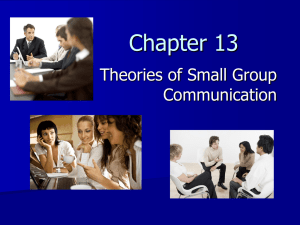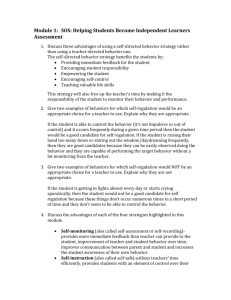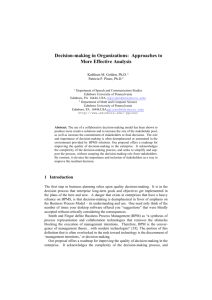In their own words: an exploratory study of bonafide Group leaders
advertisement

In their own words: an exploratory study of bonafide Group leaders Wikipedia: Bona Fide Groups is a theoretical perspective of communication in small groups that was initially developed by Linda L. Putnam and Cynthia Stohl in the 1990s. Intended to provide communication theorists with a valid model of small groups on which to conduct research, this perspective focuses on the principles of communication that take place within naturally formed social groups.[1] This represented a shift in traditional research practices which had primarily consisted of studies on zero-history laboratory groups. Putnam and Stohl describe a bona fide group as exhibiting stable yet permeable boundaries, interdependence with the immediate context of individual group members, and links between boundaries and context. These characteristics allow for important elements of small groups, such as fluctuation in group member commitment level and a shared sense of boundaries. In their call for research to move its focus toward bona fide groups, Putnam and Stohl argued that this model is more ecologically valid than alternative case studies, and as such, it gives a more accurate reading of how small groups behave on a day-to-day basis. Furthermore, since it had already helped develop current research settings, methods, and variables, it most certainly will continue to shape small group communication studies. In the time since this initial argument was proposed, social scientists have generally agreed with Putnam and Stohl, and have redirected much of their research to emphasize bona fide groups as a model of small group communication. Abstract: Leiders ondervraagd naar wat zij belangrijk vinden in het leiden van groepen 5 thema’s komen naar boven o Establishing the intention for the overall project o Building the team and developing a positive group culture o Monitoring and managing the team’s interaction o Mananging the group’s task and keeping the group focused o Communication behaviors and personal characteristics of the leader Bonafide group perspective as alternative from which to view groups (Puntam en Stohl) o Group’s boundaries and its context as key elements of its operation o Later: unstable nature of group’s borders added to the perspective o Criteria emphasizes that real-world groups are not self-contained o Boundaries do not differentiate always from environment 2 advantages It provides a sort of reality check to help scholars evaluate and modify research findings from laboratory groups o Reminds us to trat group as a social institution linked inextricably to its environment Veel gebruikt in verschillende onderzoeken: Families Mt. Everest expedition team International business consulting teams LEADERSHIP LaFasto & Larson (2001) o Describing leaders behaviors that members believe contribute to and detract from effective teamwork (Member leader) No studies about leader leader Research question: discover what successful, real-life leaders believe is important in the leadership process and what they seek to accomplish as leaders of small group WHAT DO LEADERS DO? Definition: o Hackman & Johnson: communication behavior that affects the behavior of others so that group or organizational goals can be met Focus on leader’s communicative behavior Several behaviors determined as important o Mediate group information to facilitate goal attainment o Org leaders help members make sense of org situation by monitoring their subordinates’ comprehension and adjusting own behavior accordingly o Make org goals legitimate and help followers understand relevance of their work in larger context o Conclusion: leaders, to be effective, must develop both cognitive and behavioral skills; when are these skills needed? Kickul & Neuman: leaders establish conditions that help groups move toward their goals, found several traits related to leadership emergence o Cognitive ability (along with conscientiousness) o Openness o Extraversion LaFasto & Larson o Group leadership by asking members what leader behaviors help and hinder group effectiveness 6 dimensions of leadership (leadership competencies) Focusing on the goal Ensuring collaborative climate Building confidence in team members Demonstrating sufficient technical competencies themselves Setting priorities Managing performance Findings consistent with Bowman in that leadership involves having and articulating a vision and inspiring others to commit to the vision Leadership involves the relationships with members which is less about leader’s positional authority and more about how to manage relationships Two specific skills have been associated with effective leadership o Adaptability o Self-monitoring Adaptability Key factor in leader effectiveness o Although do not always agree about the typical leader’s ability to adapt Optimistic: diagnose group needs and supply the behaviors addressing those needs (Diagnosis and adoption as important leader abilities and behaviors) Other: effective leaders can and do adapt their behaviors as needed Barge: leadership as mediation and coordination o Competent communicators who chance and adapt behavior accordingly o Room for development of these competences Indirect evidence that leaders believe they should adapt their behavior according to the situation 8 situational attributes Do leaders actually adapt? o Self-monitoring Wood: leaders adapt their communication behavior in accordance with the goals they want to achieve in a group meeting Leaders do adapt communication behavior Leaders know what what they want to accomplish during a meeting and plan in advance what they will do to accomplish during a meeting and plan in advance what they will do to accomplish those goals Conclusion: behaviorally is an important skill for leaders and leaders with les ability to adapt are less effective = type of social intelligence that refers to someone’s ability to monitor and control selfpresentation in social situations, comprises both cognitive and behavioral dimensions and has been found to be related to both leadership emergence and effectiveness Two dimensions o Sensitivity to social cues o Ability to adapt in response to thise cues High self monitor consistently are more likely to emerge as leaders of small groups (one study showed more than half the variance explained in leadership emergence Other manifestations o Evaluate org factors that affect group’s needs o Sophisticated cognitive representations of the social elements in group decision making o More quickly able to assess how effective particular adaptations are likely to e o Have wide social repertoire s on which to draw during problem solving WHAT DO LEADERS THINK? Know leaders that they are doing all that? Are these abilities conscious? How do they frame what they do? o Leaders perspectives? Broome & Fulbright: o Real-world group members identified lack of knowledge about problem-solving procedures as a serious barrier4 WHAT DO BONA FIDE, EFFECTIVE GROUP LEADERS BELIEVE IS IMPORTANT IN LEADING GROUP¨S? METHOD Sector: Leaders in several sectors in USA Research Design: Cross-sectional design Research Methods: Qualitative interviews Nature of key findings: What interviewees do as leaders and what effective leaders generally do. RESULTS (best goed nalezen in tekst zelf) Remarks and examples, describing what they and other effective group leaders do, were grouped thematically into the following five categories: o Establishing the intention for the overall project Clear and compelling goal Where team wants to go o o o o How to communicate and clarify vision How to motivate members Support of the members for the group’s goal Building the team and developing a positive group culture Both are intertwined Careful member selection Motivated, commitment, hard working and open minded Ensure to meet the needs of the members Members feel included and appreciated and appreciate each others skills, perspectives and talents Members feel free to contribute Monitoring and managing the team’s interactions during meetings Encourage participation, diversity of opinions and critical thinking,… “The group can solve the problem” Leaders are committed to the group Information management and leadership adaptation Managing the group’s task and keeping the group focused Group meetings, manage uncertainty,… Access to tools and techniques Attend to both structural and process concerns Communication behaviors and personal characteristics of the leader Inspire confidence in their ability to lead (“impression of comman”) Motivating members to support the team’s vision and goals important, but members must also have confidence that the leader will be able to get the group to its goal DISCUSSION Ecological validity of self monitoring and leadership adaptability o Relative importance of factors? What leaders said is consistent with what members said Still other factors in interviews worth exploring Still, how do leaders learn to be effective? o Academic, practical, otherwise? Supports using dialectical theory o Examines opposing forces that come into play in relationships Limitations o No diverse group (1 african American) in ethnicity, geographical location or occupational grouping o Do men and women conceive leadership differently? Ethnicity, race of group? Different leadership for different occupations? o Some respondents more talkative and reflective Leadership style and leader behavior emphasized: Effective leaders emphasize the goal, provide a collaborative climate; build team members' confidence, are technically proficient, set appropriate priorities for group, manage group's performance; importance of communication. NB wide range of forms of behavior emphasized and grouped into five categories.










